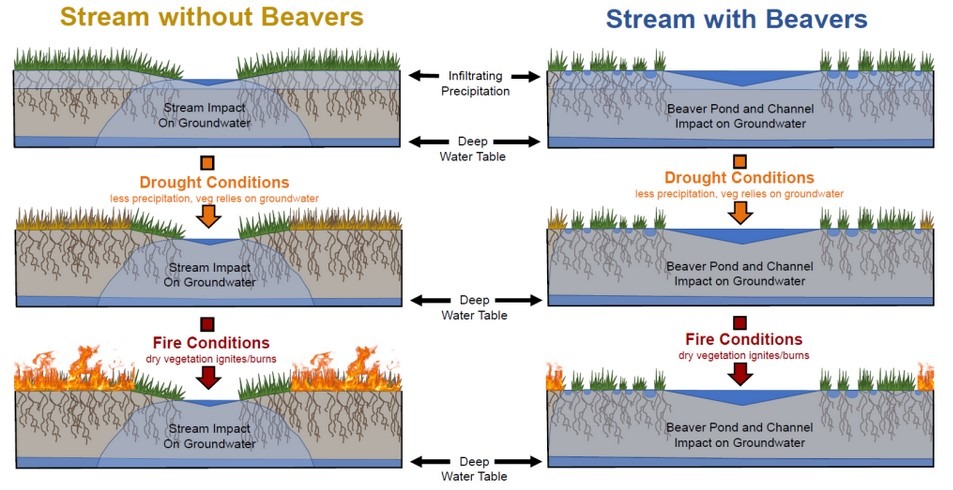More Beavers Means Less Damages from Wildfires
Article By Lauren Zatkos
We are living with wildfire threat in the Santiam Basin, and throughout Oregon, every summer. People are working hard to repair the devastation caused by the 2020 fires. Recovery takes a lot of time and money, but did you know we have ecosystem engineers who will work for free to help us lessen the damage of future wildfires?
Beavers work hard to create wetlands; and when they do, they make river ecosystems more complex and increase groundwater storage. New research is shedding light on just how beneficial beavers can be in drought-prone landscapes that are becoming more susceptible to wildfire damage.
When beavers build their dams, they slow down and back up water. This creates a much larger area of saturated soil around the beaver pond compared to saturated areas that already exist around free-flowing rivers and streams.
Saturated soils mean greener, wetter vegetation around the beaver ponds, whereas the land where people are living alongside free-flowing rivers in the northwest are drying out during our summer droughts. This photo from the Western Beavers Cooperative shows the contrast between the beaver-managed river and the surrounding burned area after the 2018 Sharp’s Fire in Idaho.
 Figure from Fairfax, E. and Whittle, A. (2020), Smokey the Beaver: beaver‐dammed riparian corridors stay green during wildfire throughout the western USA. Ecol Appl. Accepted Author Manuscript. doi:10.1002/eap.2225
Figure from Fairfax, E. and Whittle, A. (2020), Smokey the Beaver: beaver‐dammed riparian corridors stay green during wildfire throughout the western USA. Ecol Appl. Accepted Author Manuscript. doi:10.1002/eap.2225
According to a study of wildfires throughout the northwest, this increase in groundwater and plant hydration buffers waterways and river banks against moderate to high intensity fires. The resilience of wetlands against wildfires benefits people as well as sensitive fish and streams. An intact river-bank ecosystem can reduce soil erosion and ash-laden runoff that enters the waterway, maintain cooler stream temperatures during the blaze, and protect habitat that fish use to seek refuge. Birds, deer, and amphibians also seek shelter in these hydrated, resilient wetlands during a wildfire.
Beavers can help us build resiliency, reducing future damage caused by frequent and intense wildfires. People, fish, rivers, and landscapes would benefit from the work of industrious beavers and their naturally engineered watery habitats.
We think that beavers are important partners in the watershed, which is why we are a member of the Mid-Willamette Beaver Partnership. This group of watershed councils, tribes, university, and public partners is working to increase beaver benefits in local watersheds: minimizing or avoiding conflict between the animals and landowners and restoring local waterways and beaver communities.
If you want to follow our work or want to know more, let us know. Sign up for our newsletter to receive updates in your mailbox! If you would like to learn more about the ongoing research of beavers, and how they help address drought, wildfire and climate variability, check out Dr. Emily Fairfax’s work.
